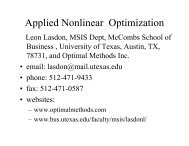Sunday
Sunday
Sunday
Create successful ePaper yourself
Turn your PDF publications into a flip-book with our unique Google optimized e-Paper software.
SA20<br />
■ SA20<br />
20- West 211 B- CC<br />
Joint Session: SPPSN/ENRE-Environment:<br />
Energy Policy and Sustainability<br />
Sponsor: Public Programs, Service and Needs & Energy,<br />
Natural Res & the Envi/ Environment and Sustainability<br />
Sponsored Session<br />
Chair: Erin Baker, University of Massachusetts, Amherst, MA,<br />
United States of America, edbaker@ecs.umass.edu<br />
1 - Decommissioning and Repowering Decisions for Renewable<br />
Power Producers<br />
Chenlu Lou, Iowa State University, 3004 Black, Ames, IA, 50011,<br />
United States of America, clou@iastate.edu, K. Jo Min<br />
There have been substantial increases in the construction and operation of wind<br />
farms across the U.S.A. and the world, which will lead to a significant number of<br />
wind farm decommissioning and repowering decisions soon. We formulate and<br />
analyze mathematical models from a real options perspective with the operation<br />
and maintenance cost following the geometric Brownian motion process, and<br />
derive managerial insights for relevant government policy makers.<br />
2 - Hydrogen Production Facility Network Design from Stochastic<br />
Green Energy Supply Source<br />
Jorge Barnett Lawton, Zaragoza Logistics Center, C/ Bari 55, Plaza,<br />
Edificio Nayade, Portal 5, Zaragoza, 50197, Spain,<br />
jbarnett@zlc.edu.es, Mozart Menezes, Jarrod Goentzel<br />
Hydrogen has been identified as a clean alternative to store energy from volatile<br />
sources. We analyze the production and distribution network design problem of a<br />
firm generating electricity from wind and producing hydrogen by electrolysis, in<br />
the presence of stochastic energy prices and supply. We provide solution<br />
approaches using column generation, and use our model to evaluate a future<br />
hydrogen supply chain in Spain, under different distribution policies and<br />
government incentive schemes.<br />
3 - R&D Portfolio Analysis of Low Carbon Energy Technologies for<br />
Climate Change Mitigation<br />
Rose Zdybel, University of Massachusetts-Amherst, 120D Marston<br />
Hall, Amherst, MA, United States of America, rozoe@msn.com<br />
We analyze R&D portfolios of low carbon advanced energy technologies for<br />
climate change mitigation. We use the GCAM integrated assessment model to<br />
analyze the effects of combinations of low carbon energy technologies on CO2<br />
concentration stabilization costs and then combine the results with probabilistic<br />
data from expert elicitations. We also develop econometric relationships between<br />
variables to estimate results for input values other than those that are part of the<br />
elicitations.<br />
4 - A Decision Support System for Managing Wind-turbines with<br />
Storage in Smart-grids<br />
Frederic Murphy, Professor, Temple University, Alter Hall 435,<br />
Philadelphia, PA, 19122, United States of America,<br />
fmurphy@temple.edu, Fernando Oliviera<br />
We analyze the wind-turbine business model given the opportunities created by<br />
the smart grid and by efficient electric battery storage systems. We model the<br />
interaction between dynamic prices and wind-regimes; we analyze how batteries<br />
can be used to improve wind-turbines reliability and profitability. We study how<br />
forward and option contracts can be used by a wind-turbine to hedge risk and we<br />
use conditional value at risk to assess the wind-turbine risk exposure and as a<br />
basis for risk-hedging.<br />
■ SA21<br />
21- West 212 A- CC<br />
Applications of Networks and Graphs<br />
Contributed Session<br />
Chair: Zeynep Ertem, Texas A&M University, Industrial & Systems<br />
Engineering, 3131 TAMU, College Station, TX, 77843,<br />
United States of America, zeynep84@tamu.edu<br />
1 - Detecting Research Fronts using Citation Network Analysis<br />
Katsuhide Fujita, The University of Tokyo, 2-11-16 Yayoi,<br />
Bunkyo-ku, Tokyo, 113-8656, Japan, fujita@ipr-ctr.t.u-tokyo.ac.jp,<br />
Yuya Kajikawa, Junichiro Mori, Ichiro Sakata<br />
One of the important methodologies for detecting the research fronts is the<br />
citation network analysis. Especially, citation network analysis with<br />
combinational types or weights has possibilities of finding the new research fronts<br />
compared with non-weighted and single type of citation networks. We perform a<br />
comparative study to investigate the each type of citation networks in detecting a<br />
research front using visibility, speed, topological relevance and keyword similarity.<br />
INFORMS Phoenix – 2012<br />
62<br />
2 - Social Network Analysis at Wine and Food Festival<br />
Bomi Kang, Associate Professor, Coastal Carolina University,<br />
P O Box 261954, Conway, SC, United States of America,<br />
bkang@coastal.edu, Young Jae Kim, Taylor Damonte<br />
Social network analysis emphasizes the importance of constructing the<br />
interconnectedness among concepts and knowledge networks in respondents’<br />
minds. The technique has gained popular use in social science over the past three<br />
decades. Using concept maps and degree centralities derived from social network<br />
analysis, authors demonstrated new insights in festivals in Myrtle Beach Area,<br />
through this novel technique.<br />
3 - Traffic Grooming in Optical Networks: Decomposition and<br />
Partial LP Relaxation<br />
Hui Wang, PhD Candidate, North Carolina State University, 2152<br />
Burlington Labs, Raleigh, NC, 27695, United States of America,<br />
hwang4@ncsu.edu, George Rouskas<br />
We consider the traffic grooming problem, a fundamental network design<br />
problem in optical networks. We propose a new decomposition approach with<br />
two subproblems: (1) virtual topology and traffic routing (VTTR), and (2) routing<br />
and wavelength assignment (RWA). We also propose an ascending utilization<br />
iterative algorithm based on partial LP relaxation to further improve the<br />
scalability of VTTR. Our approach delivers a desirable tradeoff between running<br />
time and quality of the final solution.<br />
4 - Graph Theoretical Analysis of Brain Networks<br />
Zeynep Ertem, Texas A&M University,Industrial & Systems<br />
Engineering, 3131 TAMU, College Station, TX, 77843,<br />
United States of America, zeynep84@tamu.edu, Sergiy Butenko<br />
Exploring the connectivity patterns of human brain is gaining more interest in the<br />
last decade. Correlated low frequency fluctuations in the blood oxygenation level<br />
dependent signal have been widely observed in connected brain regions. Resting<br />
state functional magnetic resonance imaging (R-fMRI) consists of hundreds of<br />
time periods for thousands of image voxels. Our aim is to model the brain as a<br />
complex network. The clusters are identified with graph theoretical analysis.<br />
■ SA22<br />
22- West 212 B- CC<br />
Topics in Real Time and Embedded Computing<br />
Sponsor: Computing Society<br />
Sponsored Session<br />
Chair: Alex Mills, Indiana University Kelley School of Business, 1309 E.<br />
Tenth Street, Bloomington, IN, 47405, United States of America,<br />
millsaf@indiana.edu<br />
1 - Optimization-based Frameworks for Dynamic Configuration of<br />
Real-time Systems with Energy Constraints<br />
Eduardo Camponogara, Professor, Federal University of Santa<br />
Catarina, Cx. P. 476, Florianopolis, 88040, Brazil,<br />
camponog@das.ufsc.br, Riad Nassiffe, George Lima<br />
Embedded real-time systems powered by batteries require suitable support for<br />
energy-savings at the operating system level. Mechanisms to do so must take into<br />
consideration not only energy constraints but also schedulability since tasks must<br />
execute within predefined time windows. Further, it is desired that application<br />
quality of service (QoS) is optimized. This talk presents two optimization-based<br />
frameworks for maximizing application QoS subject to both schedulability and<br />
energy constraints.<br />
2 - Can Randomness Buy Clairvoyance? Stochastic Scheduling of<br />
Mixed Criticality Real-time Job Systems<br />
Bader Al-Ahmad, PhD Student, University of British Columbia,<br />
2205 Lower Mall, P.O. Box 70, Vancouver, BC, V6T1Z4, Canada,<br />
baderalahmad84@gmail.com, Sathish Gopalakrishnan<br />
We pose the problem of stochastically scheduling mixed criticality jobs when job<br />
execution time distributions at all criticality levels are given. By stochastic, the<br />
dynamical evolution of the system criticality level over time is captured by a<br />
stochastic process. We ask: is such information any beneficial in reducing the<br />
pessimism of current deterministic algorithms? Our objective is to match as<br />
closely the performance of a powerful oracle that knows the future system<br />
behavior realization.<br />
3 - Temporal Logic Testing for Cyber-physical Systems<br />
Georgios Fainekos, Arizona State University,<br />
699 S. Mill Ave., Tempe, AZ, 85281, United States of America,<br />
Georgios.Fainekos@asu.edu, Sriram Sankaranarayanan<br />
One of the major challenges in Model Based Development (MBD) of Cyber-<br />
Physical Systems (CPS) is the verification of real-time functional system<br />
properties. In general, the problem is undecidable due to the interplay between<br />
continuous and discrete system dynamics. In this talk, we present how the<br />
problem of verification can be posed as an optimization problem which can be<br />
solved using stochastic optimization techniques including Monte-Carlo methods<br />
and the Cross Entropy method.



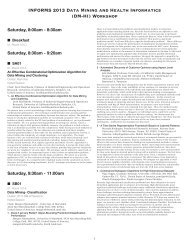
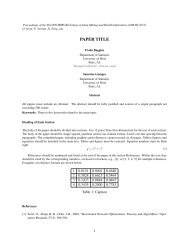
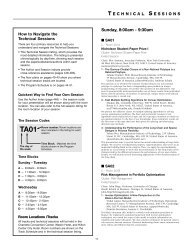
![[PDF] Charlotte Back Matter](https://img.yumpu.com/17933057/1/190x245/pdf-charlotte-back-matter.jpg?quality=85)

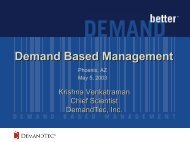
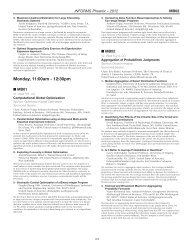
![[PDF] ALIO Back Matter](https://img.yumpu.com/17932960/1/190x245/pdf-alio-back-matter.jpg?quality=85)
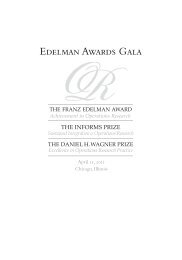
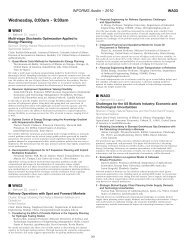
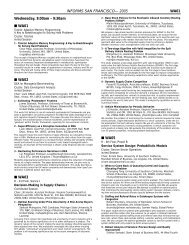
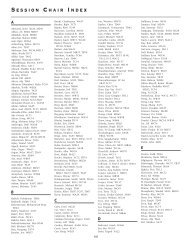
![[PDF] Monday, 8:00am - 9:30am](https://img.yumpu.com/17932954/1/190x245/pdf-monday-800am-930am.jpg?quality=85)

